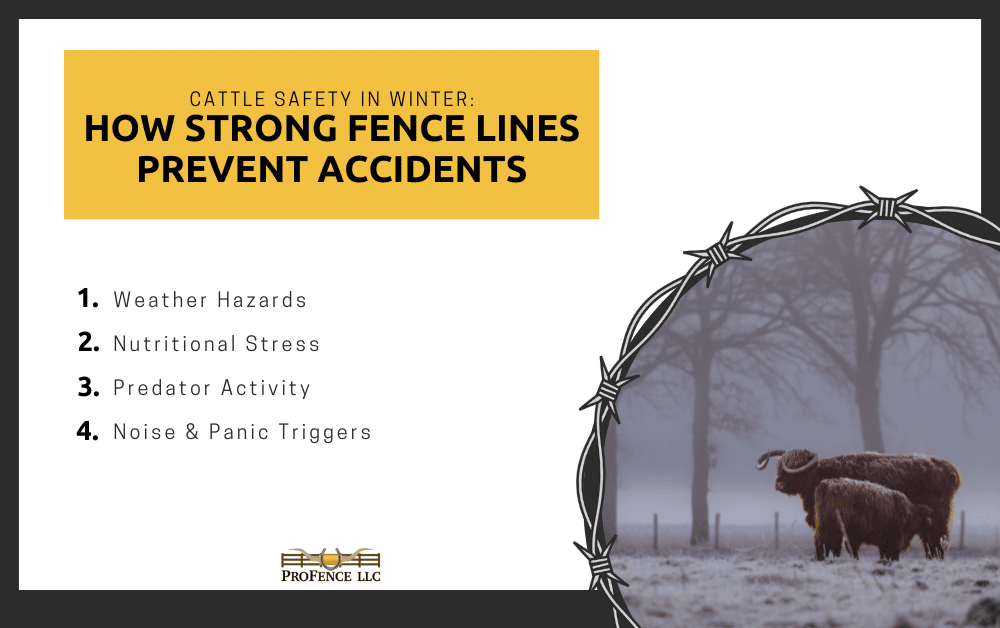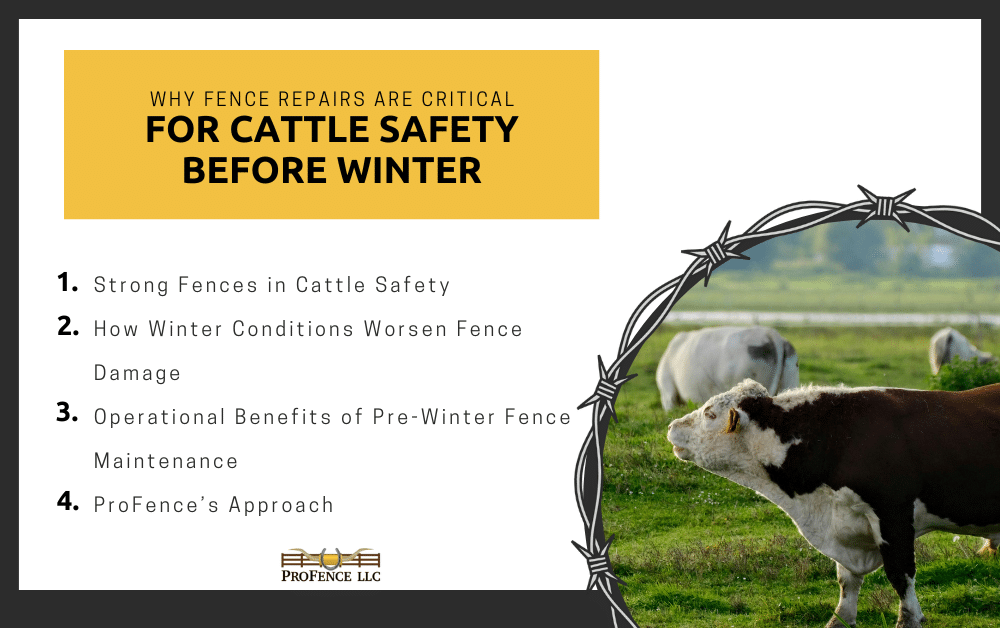When the first frost hits, farmers across the Mid-Atlantic know winter is officially on its way. For cattle owners, that means months of frozen ground, heavy snow, and icy conditions. While nutrition and shelter are often the top priorities, one essential part of cattle safety often gets overlooked: the fence line.
Strong fences are more than just barriers — they’re lifelines that protect cattle from accidents, predators, and the dangers of wandering too far in harsh weather. Weak or poorly maintained fence lines can quickly become liabilities when winter challenges set in.
In this guide, we’ll look at why winter poses unique risks for cattle, how strong fences prevent accidents, and what farmers can do to prepare before the coldest months arrive.
Why Winter Is Risky for Cattle Safety
Winter conditions amplify the stressors cattle already face. Without secure fencing, these risks can escalate into major safety and financial concerns.
Weather Hazards
- Snow drifts and ice buildup put pressure on fences, sometimes bending or snapping wire.
- Freezing rain makes footing slippery, increasing the chance cattle will push against fences when startled.
- Low visibility during snowstorms can cause animals to lose orientation, testing boundaries.
Nutritional Stress
- When forage is scarce, cattle tend to roam farther looking for food.
- Weak fence lines make it easy for hungry livestock to wander into fields, roads, or neighboring property.
Predator Activity
- Coyotes, foxes, and stray dogs become more aggressive in colder months when food is limited.
- Weak spots in fencing invite predators into cattle pastures, especially where calves are present.
Noise & Panic Triggers
- Gunshots during hunting season, snowplows, or the crack of falling tree limbs can spook livestock.
- Startled cattle often charge the nearest fence line, which exposes weak posts or sagging wire.
Winter introduces multiple challenges that push fencing systems to their limits. Only strong, reinforced fences can handle the strain.
The Role of Fence Lines in Cattle Safety
A secure fence isn’t just about keeping cattle in — it’s about protecting them from danger.
Containment
- Prevents cattle from escaping onto icy roads, where accidents are more likely.
- Reduces the risk of costly liability claims if livestock damage vehicles or property.
Protection
- Keeps predators out of pastures during lean winter months.
- Blocks deer intrusion, which can spread disease or damage stored feed areas.
Guidance
- Strong fences help cattle avoid hazardous terrain like icy ponds, ravines, or snow-covered ditches.
- Acts as a clear boundary during storms when visibility is poor.
Durability Under Winter Stress
- Reinforced fences hold firm against snow drifts, leaning cattle, and pressure from predators.
- Properly set posts withstand frost heave and ground shifting.
Common Winter Weak Points in Fence Lines
Before winter, it’s important to identify vulnerabilities that cold weather will expose.
Rotten or Shallow-Set Posts
- Posts not set deep enough are especially prone to frost heave.
- Rotten posts wobble under snow and ice pressure.
Sagging Wire
- Wire weighed down by ice or snow loses tension.
- Sagging lines invite cattle to push through.
Loose Gates
- Gates freeze or blow open in high winds.
- Weak hinges give way under pressure from spooked livestock.
Failed Repairs
- Temporary fixes (like poorly tied wire or leaning posts braced with boards) rarely hold up under winter strain.
Why Professional Help Matters
While DIY inspections help, professional expertise ensures your fencing is winter-ready.
Efficiency
- Professional crews use augers and tampers to replace posts even in tough soil.
- Large properties can be repaired much faster than with manual labor.
Regional Knowledge
- ProFence knows the soil conditions and predator patterns of the Mid-Atlantic.
- Customized solutions prevent problems specific to your farm’s terrain.
Warranty Assurance
- ProFence installations come with a 10-year warranty, offering peace of mind.
- You’re not just paying for materials — you’re investing in safety and security.
Proven Experience
- Decades of fencing livestock farms, orchards, and vineyards.
- Trusted by farmers throughout Pennsylvania, Virginia, Maryland, and surrounding states.
Cattle Safety Starts with Strong Fences
Winter is one of the toughest seasons for farmers, but it doesn’t have to be the most dangerous. Weak fences are accidents waiting to happen — from cattle escapes to predator attacks. By reinforcing your fence lines before snow, ice, and frost hit, you protect your livestock, your property, and your peace of mind.
Strong fences mean:
- Cattle stay safe and contained.
- Crops and feed areas are secure from deer and predators.
- Farmers avoid costly liability from livestock escapes.
- Winter storms don’t add unnecessary stress to your operation.
At ProFence, we know how much your cattle mean to you — and how important strong fencing is for their safety. Don’t wait until frozen soil or heavy snow exposes the weak points in your fence line.






